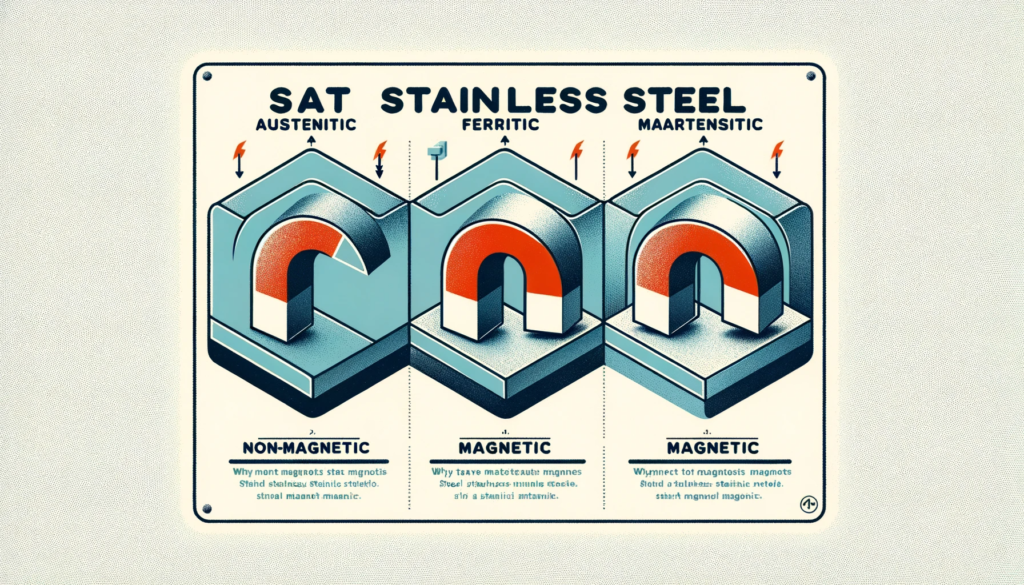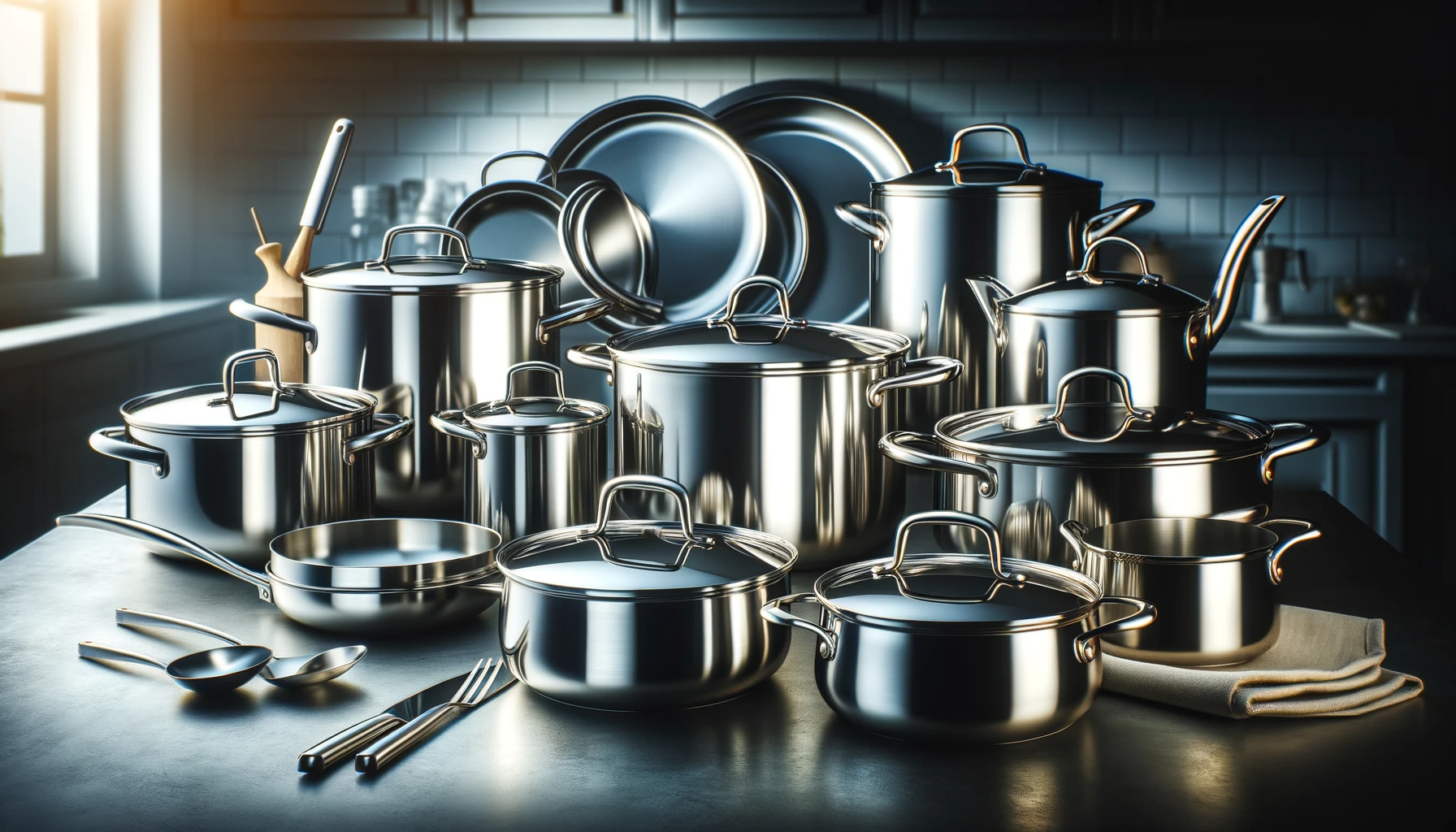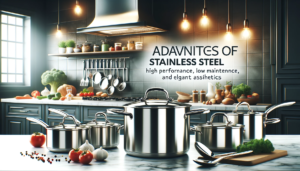Have you ever noticed your fridge magnet sticking to your stainless steel pots? The attraction seems almost magical, but is actually due to the iron contained in some grades of stainless steel.
The stickiness of magnets on stainless steel cookware depends on the formulation of the steel alloy used.
Let’s dive in to understand more about the magnetism of the various stainless steel alloys commonly used in pots, pans and bakeware.
Will a Magnet Stick to Stainless Steel Cookware?

The short answer is that it depends.
Some grades of stainless steel cookware will attract magnets, while other grades will not.
Magnets will have a hard time sticking to higher quality stainless steel pots and pans made from non-magnetic austenitic grades of steel like 304 and 316.
But lower-cost stainless steel cookware made with ferro-magnetic steel varieties containing iron can exhibit magnetism and allow magnets to cling to surfaces.
As we’ll explore further below, the variations in stainless steel alloy grades and manufacturing quality account for these differences in magnetism properties across stainless steel cookware products.
What is Stainless Steel?

Stainless steel is an very useful alloy that is made up of a combination of several metals blended together.
The most common metals that make up various types of stainless steel are iron, chromium, nickel, manganese, silicon and carbon.
The exact amounts of these components can vary quite significantly between different grades of stainless steel.
Various stainless steel alloys have different properties according to the metals they contain and their percentages within that alloy.
The addition of chromium is what gives stainless steel its most well-known and useful attributes of strength, hardness, corrosion resistance and its ‘stainless’ resistance to rust and stains.
The chromium on the surface interacts with oxygen in the air to form a super thin yet very protective passive layer of chromium oxide.
It is this ultra thin protective layer that gives stainless steel kitchenware and cookware the ability to resist rusting, pitting and staining even with heavy usage over many years.
This makes it highly useful for kitchen utensils which undergo a lot of handling and contact with water and food acids.
Due to its innate durability, corrosion resistance and ease of cleaning, stainless steel has become an exceptionally popular choice of metal for kitchenware and cookware used both by professionals chefs and home cooks.
Stainless steel is vastly popular for making pots, pans, kettles, flatware, baking sheets and tins and many other kinds of kitchen equipment.
Certain grades such as 304 or 316 stainless steel also offer very high resistance to heat damage and can withstand very high cooking temperatures making them suitable for bakeware too.
Professional kitchens almost always utilize stainless steel because not only is it durable and easy to sanitize, but it is often lightweight compared to some other metals.
Home cooks choose stainless steel kitchen items for similar reasons – it lasts a very long time with minimal care and maintenance required.
Simply washing, rinsing and drying stainless steel pots, pans and utensils after usage keeps them hygienic and in good working condition for many years before replacement is required.
This makes stainless steel products a robust, long term investment for any style of cooking.
Magnetism and Stainless Steel

On its very own, stainless steel is not innately magnetic.
For any metal item like cookware to have magnetic properties usually requires iron or some type of ferrous metal to be present along with another factor.
For a steel alloy to exhibit attraction to magnets, it must contain iron particles or shards that have been properly aligned within the metal structure so that the majority of the individual magnetic fields naturally point in the exact same magnetic direction.
However, since most grades of stainless steel do routinely contain some amount of iron shavings or particles blended together within its metal alloy matrix with the non-ferrous metals like chromium and nickel, it can sometimes be manipulated to generate enough magnetism to weakly attract external magnets.
Whether or not any individual piece of stainless steel cookware is noticeably magnetic or not depends strongly on the exact grade and formulation of the steel alloy used in its construction.
Some grades of stainless steel contain only trace amounts of iron while others have much higher percentages of iron content, making them potentially magnetic.
Testing Magnetism on Cookware

One easy non-destructive method to check if your current assortment of stainless steel pots, pans and additional cookware accessories contains enough elemental iron to be attracted to magnets is to simply try slowly moving or sliding a strong magnet across the various outer and inner surfaces of the items.
While using a typical weaker refrigerator style ceramic magnet may not provide enough magnetic field strength to produce noticeable attractive forces on stainless steel alloys with lower quantities of iron, obtaining and utilizing a more powerful rare earth neodymium magnet will aid greatly help provide more definitive and reliable test results.
Carefully holding or sliding one of these highly powerful neodymium magnet types across the inner bottom and outer sides of stainless steel pots, pans, kettles and additional cookware pieces allows a rapid test to check if they exhibit any obvious magnetic properties without damaging the items themselves.
Fully magnetic stainless steel will easily adhere strongly and sometimes suddenly snap on tightly to the magnet while stainless steel alloys with insignificant traces of iron may slowly attract to it weakly before sliding off or show zero magnetic attraction at all depending on exact steel formulation.
Typically cheaper stainless steel cookware products contain higher iron levels making them more often magnetic compared to more expensive cookware product lines which utilize much higher chromium or nickel percentages instead of iron in their proprietary metal alloy mixes which negatively impacts potential magnetism properties.
Gather Various Stainless Steel Cookware Items for Testing
To thoroughly test an entire existing collection of stainless steel pots, pans, lids, oven trays, baking dishes, kettles, mixing bowls, flatware, tongs, serving utensils and additional cookware pieces for possible magnetic behavior requires first gathering together all the stainless steel items in one general location.
Having a more rather than less varied and extensive collection of stainless steel cookware and accessory products allows running comparison tests on the magnetism results between multiple item types, manufacturers, costs and places of purchase.
It can be insightful to include thrift store finds, wedding or heirloom hand-me-down pieces, cheap big box store specials and expensive premium brand name cookware pieces all together in the same magnetism testing procedures.
This allows determining over multiple test runs whether expensive cookware Versus very low budget stainless steel cookware exhibits more or less magnetism from product to product.
Additionally it reveals if older antique stainless steel possesses different properties compared to newer manufactured products.
Carefully Run a Strong Neodymium Magnet Over All Item Surfaces
Taking care to not actually scratch the various stainless steel cookware pieces themselves during testing, run a strong industry grade neodymium rare earth magnet in a grid like pattern slowly over all sides, vertical sides, bottom surface and lid if present of each individual stainless steel item.
Being consistent in testing interior bottom and exterior sides allows reasonably comparing similar areas over numerous different products for magnetic discrepancies item by item.
Note if the magnet force easily adheres strongly to the item pulling towards it with significant attractive force or if the magnet slides off easily showing no magnetic attraction at all.
There can be variability between a magnet tightly snapping onto a stainless steel product Versus it weakly dragging, slowly sliding across the item or simply cleanly falling off with zero continuous magnetic attraction if the alloy contains scarce iron.
Check Multiple Sections of Items for Consistency
Be thorough in extensively scanning the full length vertically and horizontally over the entire inner and outer areas of each pot, pan, baking sheet and additional cookware items subject to magnet testing procedures.
This determines if results stay consistent across wide surface areas or if magnetism levels vary dramatically between different portions of the same item.
While uniform standardized magnetism properties are ideal, sometimes lower priced stainless steel cookware products can exhibit strong magnetism on sides or bottoms but not at all on handles or lids due to potential uneven blending of the metal alloys during manufacturing.
Additional magnetism differences could emerge at the top, bottom or even left, right sides of the same pan meaning quality control of metal mixing into the alloy was poor.
Top tier premium stainless steel cookware tends to ensure uniform results across the entirety of all pots, pans and bakeware pieces since careful sourcing and quality control standards verify consistency in the stainless steel alloy composition from batch to batch eliminating random variability of potential magnetism properties across a final product?s surface areas.
Why Magnets May or May Not Stick to Stainless Steel Cookware Surfaces

Whether inexpensive budget friendly Versus very pricey premium stainless steel pots, pans and additional bakeware either fully attracts and tightly adheres to moved neodymium magnets or simply causes the magnets to fall off and slide over surfaces comes primarily down to the exact formulated grade of steel alloy used.
There are quite a lot of variance between categories regarding magnetism capability stemming from chromium, nickel and carbon content balances paired with how much elemental iron gets added into the mix.
Austenitic Stainless Steel Grades are Non-Magnetic
Austenitic stainless steel alloys are considered completely non-magnetic due to elemental properties stemming from their blend recipe which includes very low iron content despite having decent nickel and chromium content.
Austenitic steel alloy grades minimizes iron in favor of adding enough nickel to alter the basic internal grain structure shapes into the ?austenite? formation shape as opposed to ferrite or martensite shapes steel grains.
It is this altered grain orientation caused by the nickel additive that eliminates magnetic permeability in austenitic stainless steel grades.
This category includes alloys like the very common 304 stainless steel and 316 stainless steel which are frequently utilized for constructing kitchenware and cookware products.
Having non-magnetic qualities while still retaining corrosion resistance means austenitic stainless steel works well for pots and pans intended for cooking tasks.
Ferritic Stainless Steel has Strong Magnetic Properties
Ferritic stainless steel alloys importantly contains iron and chromium, while also deliberately containing very low nickel percentages during formulation.
It is the alloy grain structure changing into the ferrite formations coupled with adequate levels of included iron particles that causes ferritic stainless steel cookware to become quite noticeably magnetic to externally moved magnets.
While magnetic properties are sometimes useful overall in other industrial applications, having too much magnetism is not ideal inside cooking pots and pans as it can negatively interact with induction cooking surface interfaces.
Due to this issue and also having rather low corrosion resistance, ferritic stainless steel is more rarely utilized specifically for construct cookware.
Martensitic Stainless Steel Can be Magnetic
Martensitic stainless steel metal alloy contains not only essential chromium and iron ingredients like ferritic, but also has slightly higher carbon and nickel content blended within it?s formulation That carbon addition paired with faster quenching heat processing causes the internal grain structure to shift into very strong ?martensite? crystalline formations rather than the softer austenite grains or ferrite crystals.
This again allows any included elemental iron particles to produce magnetic permeability effects since the grain formations allow the magnetic fields of the iron atoms to align rather than become randomized.
Therefore dropping a neodymium can sometimes suddenly snap onto martensitic stainless steel surfaces when used for items like cutlery or flatware.
However, just like ferritic steel, martensitic stainless has questionable corrosion resistance falling well short of the stainless steel gold standards like 316 stainless.
For these reasons martensitic stainless steel does not frequently get used to manufacture cookware.
Tips for Properly Checking Stainless Steel Cookware for Magnetism
When seeking to determine the possible level of magnetic attraction through experimentation on any stainless steel cookware possessions through casual home tests, ensure accuracy of conclusions by remembering:
Seek Strong Neodymium Rare Earth Magnets For Clear Results
Test stainless steel pans, pots, lids and bakeware with only industry grade neodymium rare earth magnets which provide very powerful magnetic field density levels up to 1.48 Teslas of magnetic flux exposure.
Standard weaker ceramic fridge style magnets giving 0.5 Tesla fields may not trigger enough attraction force reaction on stainless steel alloys containing only minute traces of elemental iron.
Strong N52 grade neodymium magnets ensure enough magnetic force to clearly differentiate non-magnetic metals Versus weakly magnetic metals through significant attraction strength Variations when doing cookware magnetism checks.
Magnet Sliding Off Easily Confirms Non-Magnetism
When testing stainless steel cookware pieces with strong neodymium magnets, quick sliding activity over flat surfaces with no hint of friction or scraping indicates rapid decisive loss of magnetic adhesion proving austenitic metals likely form the alloys.
If the magnet suddenly jerks toward surfaces, that confirms presence of easily aligned iron content within ferritic or martensitic steel metal crystalline structures.
Scan Entire Cookware Surfaces to Locate Variability
Due to how large the surface area spans across stainless steel stock pots, frying pans, baking pans and other cookware accessories, conduct testing by slowly sliding magnets across every inch of surface range both vertically and horizontally.
Magnetism adhesion could emerge only in localized areas If ferritic and non-magnetic austenitic alloys were mixed inconsistently during factory melting and forming procedures into sheets later stamped into final products.
If magnetism properties seem to disappear testing certain pot sides or pan bottoms, this reveals lower manufacturing consistency likely due to substandard quality assurance systems.
Cheaper Cookware has More Variable Steel Chemistry
With expensive premium brand name stainless steel pots and pans that cost substantially more money Versus very cheap cookware lines mass produced overseas, manufacturers of budget stainless steel are more likely to utilize scrap metals of uncertain grades simply to save costs due to wanting higher profit margins per items sold.
This contributes to chemistry fluctuations causing cookware magnetism abilities to noticeably vary across the surfaces of different pans from the same sets or even singular pans.
Top tier cookware producers are far less likely to mix together existing scrap metal leftovers into the melting pots and instead will order stainless steel ingots directly formulated to exact alloy recipes known to better resist warping and ensure even heating conduction.
Conclusion
In conclusion, whether a magnet sticks to stainless steel cookware depends on the grade of steel used.
Austenitic grades like 304 and 316 are non-magnetic, while ferritic and martensitic grades exhibit magnetism due to higher iron content.
When testing cookware, be aware that magnetism can vary if mixing was inconsistent during manufacturing.
Using a powerful rare earth magnet allows reliable testing by indicating a strong or weak attraction.
Now that you know why magnets may or may not stick, you can test your own stainless steel cookware.



